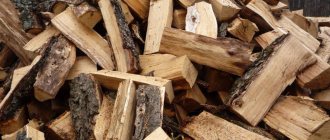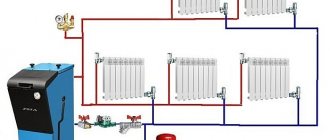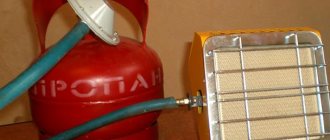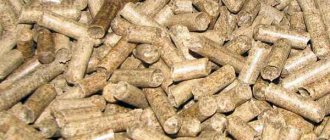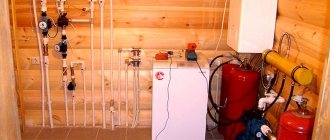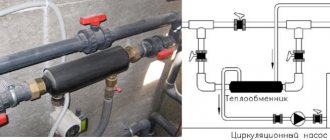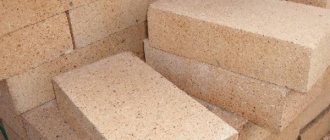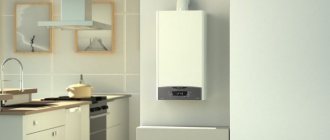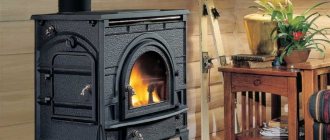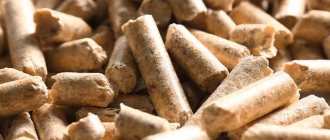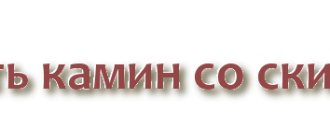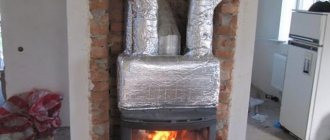What is a pellet stove?
A pellet stove is a convenient device for heating a room. No worse than a stove for heating a house. It uses pellets as fuel, which are modern, environmentally friendly and prepared in a special way in the form of fuel granules. On the modern market, pellet manufacturers make it from:
- sawdust
- peat
- potato waste.
- sunflower husks.
- straw.
- pellets.
According to experts, in the near future pellets will be able to take a leading position in the form of fuel for fireplaces and stoves.
Operating principle of a pellet stove
Pellet stoves are equipped with a special tank for a certain number of pellets. Pellets can be stacked on the side or on top. There are some differences: if pellet stoves are loaded from above, then their productivity is greater, but the quality of the pellets must be high. Side-loading pellet stoves require such a fastidious attitude to the quality of fuel.
The volume of the pellet loading tank may vary. The duration of operation of the furnace, as well as the frequency of loading fuel into the tank, depends on this. For most home and garden stoves, the standard period of operation without adding fuel is several days. The pellet stove has a control unit that regulates the intensity of the flame. You can use a thermostat that will be connected externally. During regular use, it will be necessary to clean the ash pan of the pellet stove at intervals of 1 week.
Operating principle of furnaces
Figure 4. Industrial-type pellet boiler
Pellet boilers require electricity to function. Thanks to it, the control unit, fan and auger operate. After loading the granules, they are fed in portions through a screw into the combustion chamber. Due to the absorption of air from the room, fuel ignites. It takes a maximum of 10 minutes to start the system.
Important! The independence of furnaces from power systems is conditional. Without electricity, boilers cannot operate
The gases generated during the combustion process enter the heat exchanger. From here a fan distributes them throughout the room. The smoke goes up the chimney. Most modern models are equipped with a thermostat that sets and controls a certain temperature in the room.
The resulting ash ends up in the ash pan. There is very little waste from burnt pellets. The average cleaning frequency is once a month. Advanced models require even less attention to this aspect - up to the elimination of waste every two months.
In the presence of a water heating system, along with the air, the liquid is also heated. Water circulates through the pipes, entering special containers if necessary.
Automation greatly simplifies user interaction with the stove. The computerized system makes every stage of the boiler operation more efficient and safer.
Figure 5. Boiler operation diagram
Types of pellet boilers
Heating equipment of this type is classified based on different criteria
According to the materials from which the structure is made
Most fireplaces are made from high-quality steel. Much less common are devices whose main material is cast iron.
By type of burner
There are ovens:
- flare; the most popular “household” option; Flare boilers are characterized by low power, ease of operation and adjustment, and reliability; Among the disadvantages of this type are sensitivity to fuel quality and unidirectional heating of the stove walls;
- fireplace; characteristic feature - the granules are burned in a special pellet bowl; there are fewer adjustment possibilities, and there is also a greater demand for fuel; but such stoves can be installed in rooms - the equipment is quiet and safe;
- volumetric combustion; Much more often, such burners are used in industrial-type devices, but they also have a place in household units; minus – increased bulkiness; advantages - higher power and undemanding requirements for granules (in Russian realities, the latter aspect is of considerable importance).
By fuel supply type
Furnaces are divided into:
- mechanical; the operator of such a boiler turns into a stoker, forced to constantly monitor the combustion process;
- semi-automatic; Only power is set manually here - the rest of the control falls on the shoulders of the automation; from the point of view of cost-quality ratio, this option is preferable to others;
- automatic; The user only needs to load the fuel - the automation will do the rest; but for the initial setup of the equipment, it is better to call specialists - they will make all the necessary calculations based on the size of the room, the required temperature and other parameters.
By fuel type
Figure 2. Boiler operating on pellets
Pellet boilers operate on different types of fuel. There are ovens:
- working exclusively on wood pellets; in the absence of the ability to regularly provide yourself with compressed fuel, there is no point in purchasing such equipment; Even at the stage of choosing a furnace, it is necessary to consider options for supplying granules of a suitable type;
- partially combined; the use of briquettes and firewood is allowed - this is facilitated by the format of the firebox; but the main role of fuel is played by pellets, while other options serve as a help in situations where there is no access to pellets; ignoring this rule leads to equipment failure;
- combined; these units have several fireboxes of various formats; therefore, it is allowed to use both pellets and firewood with briquettes on a regular basis; The disadvantages of combined devices are the high price and decent dimensions.
By purpose
Depending on the purpose, equipment is divided into:
- convector fireplaces; their task is to heat the air; the most popular option - such stoves take up little space, have the “right” to be placed in residential premises and easily “get along” with any interior design;
- water heating boilers; distinguished by their solid size and inexpressive appearance; they are usually installed in utility rooms or basements;
- hybrid units; the task of combined devices is both direct heating of air and heating of the coolant; in terms of design they are close to convection equipment.
Advantages and disadvantages of pellet boilers
The popularity of pellet boilers is growing due to a series of advantages. Among them:
- efficient heat transfer; The efficiency of such devices is comparable to the efficiency of gas heating devices and is significantly higher than the efficiency of wood-burning stoves;
- fuel efficiency;
- complete environmental friendliness; absence of any harmful substances in the granules;
- autonomy; provided there is an automated system, the user is deprived of the need to control the combustion process - the automation does almost everything for the person;
- independence from main power systems;
- almost complete non-waste - when burned, the granules leave a very small amount of ash; cleaning the ash pit is rarely required;
- equipment safety and no need to coordinate installation with the relevant services;
- aesthetic design of boiler-fireplaces - the ability to “fit” the unit into any interior.
Figure 6. A stove with a modern aesthetic design
is not without its drawbacks. These include:
- the need for electricity, without which ignition of fuel, operation of the auger and control unit are impossible;
- high cost of equipment; average price range – 100,000-1,000,000 rubles;
- dependence of European models on Russian energy systems and pellet quality; devices can be sensitive to power surges and require fuel; When choosing a stove, you should definitely consider protection against voltage surges and the possibility of purchasing pellets suitable for a specific model.
If you have the financial means, the advantages of stoves outweigh their disadvantages
Comparison with similar devices
The cost of electricity, as well as gas, is constantly growing, which means that pellet stoves are profitable to buy, first of all, from the point of view of benefits.
We recommend: Siberia boiler: features, advantages and disadvantages, characteristics
Since they are completely independent of external sources, the system’s dependence on suppliers automatically disappears - the home owner himself decides how much pellets he needs to purchase, for example, for one winter season.
Main differences
The main difference between fireplaces using wood pellets and stoves using dry wood is that they do not emit carbon dioxide. When wood burns, it releases carbon dioxide, and this is very dangerous for the health of the inhabitants of a country house. The ash that is formed after the combustion of pellets can be used as fertilizer on the site or in the greenhouse.
Another distinctive feature of such devices is that they can be installed in homes when there is no gas pipeline nearby or the possibility of heating using an electric unit. Moreover, even if both gas and electricity are available, if they are turned off, the pellet stove will be a backup system for heating the cottage. This is especially true in extreme cold. With proper operation of such furnaces and timely maintenance work, they can last more than 20 years.
Institutional use
The popularity of installing pellet stoves in restaurants, shopping centers, industrial premises, hotels and social institutions (hospitals, schools, kindergartens) is understandable.
The fact is that compared to gas heating, heating rooms with pellets is approximately 2 times cheaper, and if we talk about electric heating, the economic benefits can increase by 3-4 times.
Advantages and disadvantages
The pellet version of the fireplace, like any device, shows positive and negative qualities in its operation. Negative qualities are inherent in any design, so their presence does not indicate unsuccessful development. Each user chooses for himself those qualities that seduce him and what he can sacrifice. The advantages and disadvantages of a fireplace can be divided into groups.
Good to know: How to properly build a brick fireplace with a stove bench at home
Advantages:
- The time between refills directly depends on the volume of the hopper and the operating mode of the burner. One way or another, autonomous operation of the fireplace is possible throughout the day. This is an average figure, since more expensive models can work without refueling for up to two days.
- The operation of the controller not only allows you to maintain a certain temperature, but also regulates modes in non-standard situations. Any failure will result in the fireplace being shut down to ensure fire safety. Modern technologies allow automatic control of the fireplace, depending on the weather outside.
- Combustion with oxygen supply occurs much more intensely and better. Not only the heat transfer rate, but also the amount of combustion products depends on this. Volatile elements are removed using a special chimney, and the ash is collected in a special ash pit. Compared to a wood fireplace, a pellet fireplace leaves a very small amount of ash as a product.
- A fireplace without a contour can heat up to 300 m2 of room area. The presence of a circuit will not increase the area, but it is possible to install full-fledged heating for a house with several rooms.
- The pellet machine, apart from the chimney liner, does not impose any further requirements on the installation site, as it is an environmentally friendly device.
A modern type of environmentally friendly fuel
Flaws:
- The main disadvantage is the price, which is much higher than other alternative heat sources.
- Apart from specially prepared pellets, no other type of fuel is suitable for a pellet fireplace.
- The operation of a fireplace involves many moving parts. They create a characteristic noise. In addition, they require periodic maintenance in the form of diagnostics and minor repairs.
- A chimney needs to be installed.
Practical recommendations
Before you start assembling a pellet fireplace stove, you should decide what parts you need to purchase - we are talking about the burner and industrial automation. You should not experiment and assemble the burner yourself. Even if a lot of effort is put into it, its functionality may be very questionable.
It is best to purchase ready-made elements and use them later when assembling a pellet stove. If you make the boiler multifunctional, that is, provide it with a water circuit and the ability to work both on pellets for the fireplace, and on wood and coal, then in the future it can be modernized.
It is worth noting that heat exchange in these types of heating will differ only in the type of solid fuel and the method of its combustion.
The advantages of a universal boiler will be:
- If there are interruptions in the supply of pellets for the boiler, the boiler can still be used. To do this, remove one burner and put on another to heat the stove with prepared wood and coal.
- Alternatively, you can install a special burner in the boiler for burning natural gas or liquid fuel.
The combustion chamber is usually made of heat-resistant steel 5 mm thick. It is advisable to use ST20 carbon steel for these purposes, but the casing can be made of ST3 sheet steel with a thickness of 3 mm. The fire tubes and chamber doors are made of 6 mm steel, and the grate should be as much as 10 mm thick. In order not to bother with purchasing and assembling parts, sometimes it is much easier to purchase ready-made equipment.
If you make the boiler yourself, you will need a welding machine. The water grate must have very rigid walls. To do this, metal corners or pieces of reinforcement are sometimes welded onto them. At the end of the work, it is necessary to double-check the reliability of all welds. If flaws are found, they must be eliminated.
Types of heat exchangers for pellet stoves
The design of a long-burning pellet stove can include two types of heat exchangers to which heat is transferred from the flue gases:
- water tube;
- fire tube
In a water-tube heat exchanger, water is heated from pipes heated during the combustion of pellets. But hot carbon monoxide passes through the fire tube circuit, and the combustion energy is transferred to the water jacket. This is not the most popular type of heat exchanger for a solid fuel boiler.
Its efficiency can be increased if it is made two- or three-pass, that is, thermal energy will move through the pipes, changing direction 2-3 times and passing several circles. As a result, the water jacket absorbs the maximum amount of heat, and the exiting smoke will be heated to 150 ℃.
To make it clearer, we will describe the operating principle of an automatic pellet stove with a fire tube heat exchanger. So, the burner burns solid fuel, as a result of which the walls of the fuel chamber and the coolant inside the boiler casing heat up. Carbon monoxide is evacuated under the influence of draft and fan through flame tubes, also transferring heat to the water jacket, after which it finally exits into the chimney. The combustion intensity is determined by the controller, which relies on data received from the temperature sensor. It is lowered into water at the outlet of the boiler.
The main advantage of pellet stoves with a water circuit, assembled with your own hands or purchased ready-made, is their automatic operation mode. She doesn't need to devote much time while working.
Assembly Guide
A self-assembled pellet stove is a unit consisting of a burner, a housing with a heat exchanger, a firebox, a hopper and a screw mechanism (it is used to supply pressed fuel to the boiler)
Burner
The burner used in furnaces may have a different design; drawings are drawn up for them separately, since the technical characteristics and operating principles will also differ. The volumetric burner is installed during self-assembly directly into the firebox of the heating device. The main burner materials are steel and cast iron.
Pellet burner design
It must be remembered that a homemade pellet burner for a boiler will not meet safety requirements without prior control by a specialist, since an ordinary person may not know all the intricacies of the work. The burner must be installed in strict accordance with the regulations.
Also, a burner for a pellet boiler assembled by yourself can be supplemented with an ignition system. It can be manual or automatic. If automatic is selected, you will need to additionally install an electric fan. The torch burner differs from other options in its low power and has compact dimensions convenient for use at home.
The retort burner has the shape of a bowl. It is filled from below. The fan supplies air to the combustion zone, which enters the burner through special small holes.
Methods of supplying fuel to the burner
Purchase
A burner assembled in production conditions will require serious investment. The average cost of a finished product is about 75,000 rubles. The cost is affected by:
- Manufacturer.
- Materials used.
- Dimensions.
- Ignition type.
In order to save money, it is proposed to create a burner with your own hands according to existing diagrams and drawings.
DIY making
A homemade pellet boiler, the drawings of which are selected for work, must correspond to the type of burner. You can also make it yourself. The burner operating in the unit is fireproof. The service life with proper assembly is at least 10-15 years (production options can work up to 20 years). All the tools and components that the burner requires can be purchased at a regular store.
Pellet burner diagram
The parameters should be calculated using a specialist or a special calculator. Video on installation work related to the burner:
Housing and heat exchanger
It is recommended to make the body from fireclay bricks (resistant to high temperatures, overheating and temperature changes). Cast iron is also suitable for this element.
The heat exchanger is created from pipes. They must have a square cross-section. It is necessary to make holes in order to later bring round pipes. The material is sheet steel, the thickness is 4-6 mm. There should be technical doors in the front and rear walls (required for maintenance of the unit). Tools – welding machine and drill.
The heat exchanger, according to the available diagrams, is located inside the boiler body.
Design example
Firebox
Pellets are poured here and fall into the burner.
Operating procedure:
It is necessary to purchase an auger with a diameter of 7.5 to 10 cm, a metal container and an electric motor. The motor is connected to the burner control unit. You can use any thick-walled casing as a metal container. An inlet pipe is connected to one part of the auger, and a corrugated tube is connected to the second. The fuel supply will pass through it.
Hopper and screw mechanism
To make your own you will need:
- auger with a diameter of 75 mm or 100 mm,
- metal casing
- a simple electric motor that connects to the burner control unit.
We recommend: Panel heating radiators (37 photos): metal batteries with side and bottom connections, power ratings and owner reviews of use
The bunker is best made of steel.
Video instruction:
General concepts and features
Pellet fireplaces are hearths that belong to the category of solid fuel stoves and fireplaces, since a real fire burns in their hearth. Due to this, special pellets are used for kindling and work, as well as for generating thermal energy. They have a small mass, an oblong elongated shape, and are sold in any specialized store.
These pellets are based on compressed sawdust, wood processing products, which are in no way inferior to firewood and coal, and in some respects, even surpass them.
Since solid fuel fireplaces must withstand not only regular exposure to high temperatures, but also their sudden changes, fireplaces are based on only the best heat-resistant materials, such as steel and cast iron.
Before you buy a pellet fireplace, it is important to know that there is a large selection of different designs. Often, a steel or cast iron body is complemented by various claddings and doors made of transparent tempered glass, through which you can control the combustion process or simply receive aesthetic pleasure.
The shape of the products is very different, as well as the dimensions and the way the objects are arranged. Also, the differences lie in the functionality of solid fuel heating equipment, which can be:
- With water jacket. Variations supplemented with a water heating circuit are connected to heating radiators and are capable of heating an entire house, transferring thermal energy along with hot water through pipes;
- Airborne. This option is classic; it is less efficient than the previous one, since heating in this case is carried out due to the heated air in the room. Thus, with its help you can heat a small house or a few large rooms at most.
Ignition in pellet fireplaces is mainly carried out in asthmatic mode, that is, using electricity. However, it is quite possible to purchase a model that does not connect to the electrical network.
Fireboxes belonging to this category are distinguished by durability, reliability, and simple operation. If we talk about specific models, the Thermal pellet fireplace is very popular, which allows you to heat the whole house, and at the same time belongs to the economical category.
The advantages of pellet stoves and fireplaces are as follows:
- Such hearths have small overall dimensions, due to which they are suitable for installation and placement in rooms with limited space, including traditional small kitchens;
- The system is fully automated, due to which each process is under constant control and does not require human monitoring;
- All fireboxes fully comply with all fire safety standards and requirements;
- The most effective are furnaces that have a long-term combustion chamber and secondary combustion. This also ensures maximum fuel economy. The efficiency of such designs is also very high and can reach about 80-85 percent;
- Large set of functions. All fireboxes that are produced today by domestic and foreign manufacturers belong to the multifunctional category. Thus, you can manually adjust the combustion intensity, set the combustion mode, set the start time and much more. For this, both special buttons and levers on the panels and a remote control are used;
- The average service life of such a fireplace is about 20 years, which is very good compared to other varieties.
In addition to their advantages, such fireboxes also have a number of significant disadvantages, which you also need to pay attention to before buying, for example, a Termal pellet fireplace.
The disadvantages include the rather high price, in comparison with electric fireplaces or traditional cast iron and steel hearths, which use wood or coal to operate. Also, it should be noted that for the operation of almost all models, you can use only electricity or pellets, but not firewood.
After the fire in the firebox has completely burned out, the heat quickly leaves, the structure cools quite quickly, especially when compared with stoves and fireplaces made of brick or with those for which natural stone was used for cladding. For such a design, a gas duct based on heat-resistant steel will be required. Also, at the moment when ash is being removed, the fireplace can make quite loud and unpleasant sounds.
Installation
The installation method for a homemade pellet boiler is practically no different from the installation of other types of solid fuel equipment. The main task in this case is to correctly place the boiler itself and the fuel supply auger. A distance of 70 cm must be maintained between the individual modules, and 2 meters of free space must be left in front of the boiler itself. The supply of coolant to the heating boiler at the time of its ignition can lead to condensation with ash and soot. It is very difficult to remove. Therefore, during the installation of the boiler, it is connected to the water circuit, in which the mixing unit is built-in.
As a rule, a three-way valve is used, which supplies coolant inside the water jacket only after warming up to the appropriate temperature. In this case, the circulation pump forces the water to circulate in a small circle. As soon as it heats up, the three-way valve gradually mixes it into the coolant of the heating circuit until it completely closes the small circle.
Please note that system security must be ensured. It assumes the presence of a pressure sensor and a safety valve installed on the outlet pipe. These measures are mandatory so that the oven can be used without any danger.
In conclusion, we note that the efficiency of industrially produced pellet stoves is much higher. However, homemade devices are much cheaper and more reliable in operation.
Device connection features
The fireplace is connected using a chimney. It seals the hole on the back of the heater and the chimney. Before installation, you should first check the presence of draft in the channel for the smoke to exit from the stove.
When installing pellet fireplaces, you must follow a number of rules:
- The chimney should not go deep into the chimney opening so as not to disrupt the air supply.
- The heater must stand on a flat surface. To ensure maximum stability, it is best to install the fireplace on an uncoated floor. In this case, be sure to check with a building level that there are no tilts.
- The room intended for the operation of the stove requires a constant supply of fresh air.
- The fireplace must not be installed near flammable objects or refrigeration devices.
- Before connecting the cord to the network, check it for damage. Do not pass it through the heating parts of the fireplace.
If it is necessary to connect a device with a water circuit, then the next step after installing the device is connecting the coolant supply and discharge pipes. The hot water supply is connected to the upper outlet of the fireplace using adapters included with the equipment.
A pellet fireplace with a water circuit allows you to warm up the entire house
The return pipe is attached to the pipe from below. After installing the pipeline, you need to check all connections for leaks.
Before installing any fireplace model, you should study the attached instructions, which will help you understand in detail all the features of connecting this device. For safety reasons, it is recommended that installation be carried out by professionals to ensure proper operation of the device.
Manually firing the stove with pellets
One of the simplest and cheapest formats for using such pellets involves manually adding fuel to the stove. For many people, this process seems unnecessarily complicated and incomprehensible, since the first time it is not possible to calculate the exact amount of fuel and the time of its addition.
After just a few times, you will be able to understand the features of the process and will easily control the flame power and the “operating” combustion temperature.
You can heat a stove with pellets in a conventional stove without significant modifications:
- The easiest way is to install a specialized basket in the oven. It has a fine-mesh structure, which prevents burnt pellets from falling into the ash pit. The cost of such products is extremely affordable, so every stove owner can afford it.
- If you want to do the work yourself without purchasing additional products, you should manually reduce the gaps between the grates. To do this, you need to re-weld the grate with a decrease in clearance or install a special mesh, which is made of thickened wire.
Using a pellet burner for a stove
Modernization of a wood-burning pellet stove by installing a burner device is optimally suited for heat generators operating using long-burning principles. After installing the burner, it is possible to achieve maximum heat transfer and economical consumption of pellets.
Converting the stove from wood to pellets is carried out by installing a mounted or built-in burner connected to a screw transmission and a fuel hopper. The design of the burner device consists of several important elements:
- The operation of an automatic pellet burner is controlled by a microprocessor chip. The controller selects the feed rate of granules and, in the event of an emergency, turns off the operation of the equipment.
- Transport feed – the equipment for organizing the supply of pellets includes: a screw feed, an electric motor. The nodes are connected to a controller that regulates their operation.
- Ignition and flame control system. Ignition is carried out as soon as the system starts. When the flame dies out, the pellets are re-ignited automatically.
A long-burning wood stove converted to pellets is economical. Given the availability of pressed pellets, heating costs are reduced by 30-40%.
The burner has a removable design. A long-burning heating stove operating on pellets and wood can be converted from one type of fuel to another within 10-15 minutes. For modification, there is no need for qualified assistance. It is enough to remove the burner and install the firebox door back.
Installing a pellet burner in a brick stove
Aqua fireplace
A pellet aqua fireplace is an effective heating device that is economical and safe.
Its installation is possible in cottages, country houses and city apartments. Heating with a fireplace with a water jacket is also suitable for commercial and industrial facilities (cafes, warehouses, workshops, etc.) The fireplace is designed for connection to radiators, heated floors and other heating devices. The fuel for it is pellets - granules from sawdust. They are supplied automatically, which greatly simplifies the process of operating the fireplace. The fuel bunker is designed for 1-2 days of continuous use.
In most cases, a fireplace stove with a water jacket can be used as the main heating device in your home, the main thing is to choose the right power.
Heating with pellets: profitable or not, myths and reviews
Let's consider the most common questions regarding the benefits of heating with pellets, their pros and cons:
- Pellets burn better than firewood, is it really possible that something is added to them and this makes them less environmentally friendly? In fact, this is a fairly common and also erroneous opinion. As mentioned above, only harmless raw materials are used for the production of fuel pellets. For example, substances that do not pose a threat to human health are also used as binders for wood waste.
Answering specifically the question of why pellets burn better than firewood, first of all you need to say this:
Is heating with pellets profitable?
- The density of fuel granules (pellets) is an order of magnitude higher than that of wood;
- The humidity of pellets is lower.
In addition, the structure of the pellets itself contributes to their better combustion. Do not forget that pellets are burned in boilers specially designed for this purpose, with forced air supply.
How many pellets do you need to heat a house?
- You need much less pellets than firewood to heat the same room. Indeed, heating with pellets shows good results in terms of calorific value. For example, just one kilogram of pellets can produce about 5 kW of heat per hour. Considering that to comfortably heat 10 sq/m you need only 1 kW of heat, then with five kilowatts you can heat a small house of 50 square meters.
Heating boiler using pellets
- Will pellets burn in a regular stove or boiler? Without a heating boiler with forced air supply into the combustion chamber, it is quite difficult to use fuel pellets for heating. They will burn, but then we can’t talk about any savings, and the combustion of pellets, in this case, will largely depend on how good the draft in the chimney is.
- Pellets can be stored as much as you like, anywhere, and in any conditions. No, this opinion is wrong, and there are a number of strict requirements for storing pellets. Firstly, pellets are afraid of moisture, which, when it comes into contact with them, is successfully absorbed by the granules, after which they also crumble into pieces and become unsuitable for use. Therefore, pellets should only be stored in dry rooms, avoiding sudden temperature changes in them, in order to avoid the formation of condensation.
Gray or white pellets - which is better?
- 5. Which pellets are better, white or gray? This question is also a common misconception among those who decide to switch to pellet heating.
The color of fuel pellets has nothing to do with their quality, which can only be determined after burning a certain amount of this fuel. And, nevertheless, there are clear visual signs of identifying high-quality and low-quality pellets. So, for example, high-quality pellets should be free of cracks, have a length of at least 7 mm, shine in the light and not crumble if you try to lightly rub them in the palm of your hand.
We recommend: Infrared heated floor under linoleum: installation, instructions, video reviews
Is it possible to burn a regular stove with pellets?
It was previously mentioned that pellets are extremely active in everyday life, but a special stove and burner system is required to ensure a normal flame and a uniform heat transfer process.
Despite a number of limitations, pellets can be burned without much difficulty in a conventional stove, however, the advantages of fuel in this format of use are often lost.
The main positive features of the material are:
- Long burning life;
- Low emission of smoke and toxic substances;
- High amount of thermal energy;
- Burnout uniformity.
Most often, minor modifications are required according to proven schemes. All of them differ from each other in their complexity, cost of implementation and the need for additional equipment. Despite all the difficulties, already in the first hours after the upgrade you will be able to forget about the difficulties that haunted you earlier.
Mistakes when using pellet stoves
A pellet boiler can be expensive and of high quality, but if the choice of the device was wrong, disappointment is inevitable. The main mistake lies in the general incompatibility of the boiler with the goals of consumers. It is necessary to clearly understand your needs and how much the oven can satisfy them. First of all, equipment must be assessed in terms of its type and selection criteria.
A common mistake is incorrect calculation of boiler power and room heat loss. The result is too low or too high a temperature. It is better to spend more time, but make the right calculations. It’s even better to entrust this to a specialist.
Poor furnace performance is another annoying problem. It is usually connected (if we are not talking about low-quality equipment) with the typical realities for Russia - mentioned by the poor quality of electrical networks and fuel.
Let's briefly list three more possible troubles:
- chimney sparking; the reason is the wrong choice of the latter;
- wood dust flying around the room; the reason is an incorrect choice of location for the stove;
- increased frequency of filling the ash pan; The reason is incorrect setting of the pellet burner.
Which is better to choose – a fireplace or a pellet boiler?
The choice depends on the buyer's personal preferences and desires, but there are several factors that will help make the best decision:
- Cost – a pellet boiler is cheaper than an aqua fireplace.
- Aesthetic value – fireplaces are decorative items that decorate a room. The portals offered in particular by Palazzetti are a real work of art. The boiler is intended exclusively for heating.
- Thermal efficiency - German Hark and MCZ fireplaces have an efficiency of almost 96%, which exceeds the same figure for some boilers. Klover products have a modest 80%.
- Water heating is the main method of supplying hot water for fireplaces, connecting an indirect heating boiler, which requires additional costs. The boilers are equipped with a second circuit for hot water supply.
Fireplace or boiler? Judging by the fact that cost plays a decisive role in making a decision regarding the choice of heating equipment, it is better to buy a boiler. But, if you need not just a heat source, but a separate decorative element, you cannot do without an aqua fireplace.
Profitable arithmetic
Before installing a pellet fireplace, it is necessary to consider issues of feasibility and profitability. First of all, do not forget that the fireplace is not a complete source of heat. However, this type of fireplace is not suitable as an additional source due to its high cost.
Good to know: Brick barbecue fireplace, subtleties of self-construction
Fireplace power ratings range from 3 to 15 kW. Theoretically, a power of 1 kW is enough to heat 10-15 m2 of area. But the increased efficiency, which reaches 95%, increases coverage. However, there are some recommendations for choosing a fireplace or boiler. Up to 100 m2 can be safely heated with a fireplace. The fireplace will also cope with an area from 100 to 300 m2, but here boilers begin to enter the “arena”, and indicators over 300 m2 are not available for fireplaces.
Mobile home heating device
Brands of automatic pellet aqua fireplaces
Aqua fireplaces are produced by leading manufacturers of solid fuel equipment. High-quality products are manufactured in Europe. Judging by customer reviews, the following models are worth purchasing:
- La Nordica Melinda Idro and La Nordica Graziosa Lux Plus are products of the Italian concern, characterized by the constant introduction of new technologies to increase heat transfer and automate the combustion process.
- EdilKamin Detroit and EdilKamin Boston are another example of the Italian approach to solving the problem of automation. Fireplaces operate in completely autonomous mode. The launch is carried out remotely.
- Palazzetti Martina IDRO LUX and Palazzetti Camilla IDRO - the manufacturer offers products made in modern and classic styles. Fireplaces have built-in and attached versions. If desired, cladding panels are supplied as an additional option.
- Klover Diva Plus is the difference between the series and its high thermal efficiency. The main purpose is to heat medium-sized houses.
- MCZ Ego Hydro and MCZ Club Hydro - a series of a German brand, are distinguished by high thermal efficiency and efficiency reaching 95.5%. The heat exchanger is made of gray cast iron.
- Hark ProAqua is a representative of the German school that produces solid fuel heating equipment. The models are distinguished by ease of setup and operation, and high operational reliability.
Best models
Fireplace installations Termal
Among the most popular lines of domestic and foreign manufacturers, one of the most inexpensive, high-quality and multifunctional, are termal pellet fireplaces. Today, the line includes about 20 different items.
Fireplace installations are produced in Russia, Italy and Macedonia. The production uses the latest and most innovative equipment.
The main advantages of the termal line include:
- The best and multifunctional equipment manufactured in European factories;
- Affordable cost, which is achieved through assembly work at factories in Macedonia;
- High-quality and high-strength materials ensuring easy use and durability of the structure;
- Possibility of fully autonomous operation in a given mode;
- high power and convenient connection;
- Uniform and efficient heating of the private sector;
- Possibility to use the installation as the main source of heating;
- Impeccable service, availability of all original parts, consumables and components.
Pellet fireplace Termal
Pellet fireplace for a small living room
Massive pellet construction
By choosing this type of heating, you get a lot of new opportunities:
- The design is completely ready for use. In order to connect such an installation it will take no more than one day;
- All work is fully automated. Some models can operate without refueling for up to four days. The newest models are controlled via a Wi-Fi Internet connection;
- Availability of a timer and several standard operating modes;
- Thanks to its small overall dimensions and universal design, such a heating structure can be installed in any room: living room, kitchen, bedroom, studio;
- A stationary system allows you to install your own individual chimney for such a unit;
- This line has fully automated control, which allows you to regulate the flow and level of heat, power, time, room temperature;
- The newest models are equipped with a digital interface that allows you to get maximum comfort when using.
Tip: after watching the video, pellet fireplaces, you can familiarize yourself with all the models in the termal line and choose the most suitable option for yourself. You can also learn more about all the most accurate, detailed characteristics and descriptions, as well as buy a fireplace at the lowest prices in our online store.
How to choose a pellet installation
A pellet fireplace stove, depending on the manufacturer and the chosen model, may have its own distinctive features. By following simple rules, you can choose the most suitable option that will fully meet all the stated requirements:
| Characteristics | Description |
| Construction type | Pellet stoves and fireplaces can have different types of design and position: wall-mounted, island-mounted, hanging, built-in, corner. Also, many models can have a water circuit (how to make a heating stove with a water circuit with your own hands), which allows you to evenly and quickly heat all rooms of the house using a common heating system. |
| Power | Each model has a certain power, designed to heat a house with a certain area. If the walls of your house are insulated and there are double-glazed windows on the windows, you can calculate the required power using the following scheme: 10 square meters = 1 kW. |
| dimensions | Pellet fireplace stoves can have different overall dimensions. Choose the installation in such a way that in the future it does not look too bulky or, on the contrary, very small and unnoticeable. Unlike classic wood-burning installations, pellet structures are installed not in the living room, but in the kitchen. |
| Functional | Even despite the fairly large number of functions, control is quite simple. In order to become familiar with the full range of functions, you will need special instructions with detailed tips and recommendations from the manufacturer, which comes with the heating installation. You can set the required values using two mandatory modes - temperature and time adjustments. This will allow the oven to turn on or off independently if necessary. |
Advice: when choosing a pellet boiler for a fireplace, first of all pay attention to fuel consumption and its power, which should be enough to heat a house of a certain area.
To learn more about the most popular and multifunctional models, which you can buy in our online store at the most affordable prices, you can look at the photos located in this article.
